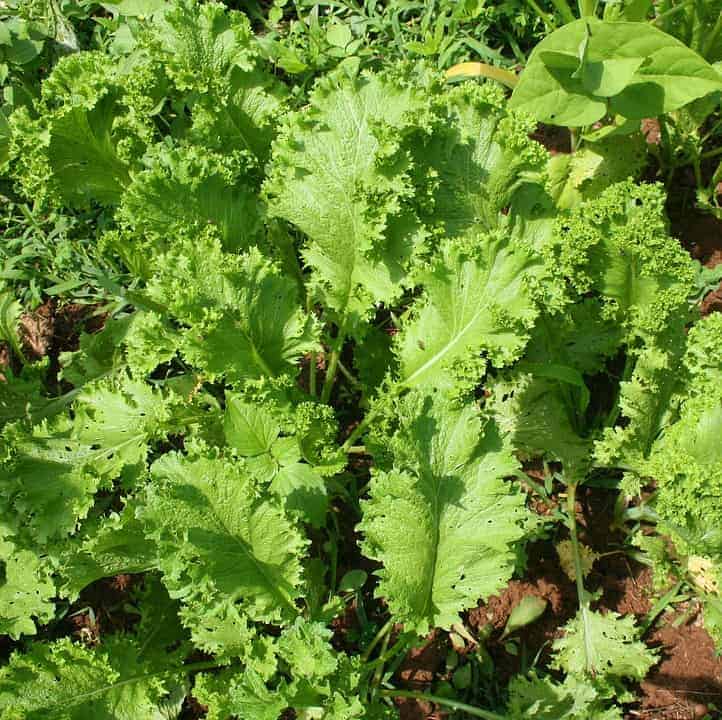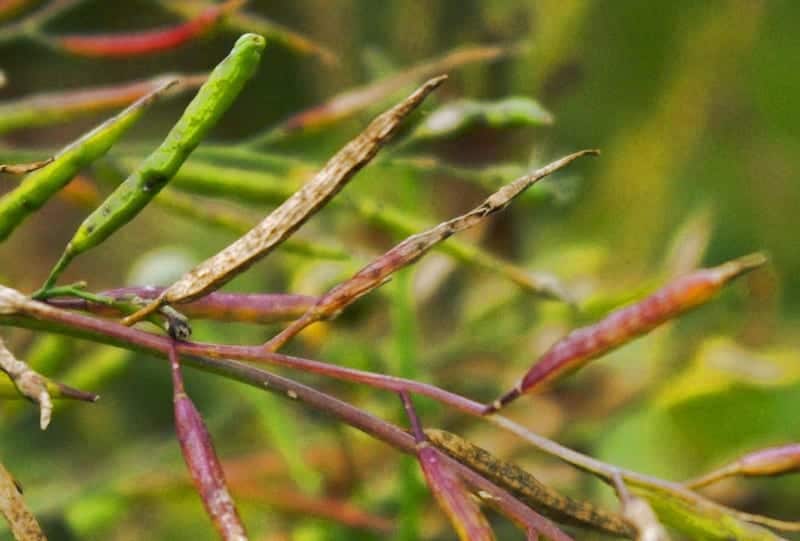We know mustard from the quintessential yellow condiment, but it’s a much more versatile plant. You can eat the leaves, buds, flowers, and the seeds. Planting your mustard seeds in pots can give you a near endless supply of fresh spicy greens and a nice harvest of seeds at the end.
What can you do with mustard seeds? Aside from making actual yellow/Dijon/grain mustard, you can use them as spices in cooking and mustard seeds can be grown into delicious, spicy microgreens.
I go into a lot more detail on my article on how to grow mustard greens, which also apply to growing mustard seeds in pots. However, there are specific things to consider when growing mustard seeds in pots.
On this page:
Pot size and spacing depends on what you want to harvest
Are you growing mustard for just the seeds? The leaves? Both? What you’re growing mustard for will influence how close you should plant your mustard seeds.
For full-sized mustard greens (which can sometimes get to the size of collards), you should be growing one mustard plant in at least 1 1/2 to 2-gallon pots.
If you’re growing mustard for smaller greens for salads and stir-fries, you can grow 16 mustard plants in one square foot of space. For baby greens, you can pack them in even closer.
If you are mainly interested in growing mustard plants for seeds so you can make your own mustard condiment then how closely you plant your mustard greens is less important. I’ve grown 4 mustard plants in a pot that was slightly more than 1 gallon in size, and they gave me over a month of delicious salad greens before they started going to seed.
Use row covers and/or shade cloth to extend your growing season
If you live in the Northeast, you’re probably disappointed every time spring comes around and you get a couple weeks of spring weather before the summer heat rolls in. If you live in the Southwest, you might have the opposite problem and can’t grow greens like mustard in the summer at all because it’s too hot (high heat and dry environments can cause leafy greens to prematurely go to seed).

In both cases, row covers and shade cloth are your friend. Row covers are generally a white fabric or clear plastic that acts as a makeshift greenhouse; they’re called row covers because they traditionally are used to cover rows of crops on farms, but you can use any kind of clear plastic sheeting, glass jars, or homemade cold frames draped over your pots.
Despite being frost hardy, mustard grows more slowly in cold weather, so using row covers in early spring can help keep the soil and air warm around your mustard plants so you can get an earlier harvest. Just remember to remove the row cover when the weather gets warmer.
Shade cloth is used for the opposite situation. When temperatures get too hot during the height of summer, this can cause your plants to go to seed (called bolting) too early. Even if you want to grow mustard for seeds, it’s good to let the plant grow and mature first so it can put more energy into more prolific blooms which will mean more seeds for you.
Shade cloth is generally black or dark green, and is graded based on how much sunlight it blocks. 30-50% shade cloth is most commonly used, but they can range from 5% to 95%. Shade cloth is a good investment overall since it can also protect your other vegetables during heat waves.
It’s better to underfertilize than overfertilize mustard
I think it’s important to ensure that your plants have all the nutrients they need. Whether you go organic or use the blue stuff, feeding your plants is one important step to getting more bountiful harvests.
But more is not always better. If you fertilize too much, you can burn the roots of your plants and ruin your crop. Always follow the instructions of whatever fertilizer you choose, and don’t be afraid to err on the side of caution and use a little bit less.
Mustard plants are very resilient and can thrive with little fertilizer, but can give you more mustard greens and seeds than you know what to do with if given a boost of nutrients.
Don’t be afraid to move your pots around and take advantage of microclimates
One of the main advantages of growing any vegetables in pots is that you can have greater control over their growing environment.
If you don’t opt to use shade cloth or a row cover, you can move your mustard pots around to protect them from the environment. Use the microclimates around your home to your advantage. Did you know that pots placed near a north-facing or east-facing wall of your home will be a few degrees warmer than those placed farther away? Heat radiates from your home, which creates a warm microclimate around it. Walls also absorb heat during the day and release it gradually at night.
In the same vein, you can move your pots to a shady part of your garden in order to give your mustard some relief from the heat.
You can read more about planning a garden around microclimates here.
Lastly, if you’re expecting severe weather, like hailstorms or high winds, you can move your mustard out of harm’s way.
Harvest mustard leaves regularly and harvest mustard seeds after your plants start dying back (also, how to harvest mustard seeds)
If you’re only growing mustard in pots to harvest mustard seeds, you should also be eating the leaves as well. Even if you don’t like the flavor by itself, it gives a nice kick to salads and stir-fries.

Like all leafy green vegetables, mustard greens can be harvested at any stage, but if left on the plant too long, the older leaves near the bottom of the plant will gradually turn yellow and die off. Harvesting mustard leaves means you get a continual harvest of fresh greens while waiting for your plants to flower and produce more mustard seeds.
Mustard seeds should only be harvested when the seed pods and stems have turned dry and yellow or brown. You will know they’re ready because the seed pods will be extremely delicate to touch and feel dry like paper.
How to harvest mustard seeds: Carefully cut a branch with dried seed pods without shaking it too much (seeds will spill everywhere) and over a bowl, start gently rubbing the mature seed pods between your hands and let the pods and seeds fall into the bowl.
To separate the empty seed pod husks from the seeds in the bowl, you can shake the seeds gently while blowing away the dried, empty pods. Tiny bits of stem might remain but you can use a strainer to filter them out.
Store your seeds in an airtight container for long-term storage. If you want to save mustard seeds for replanting next year, also keep them in a cool, dry place.
Tip: If your mustard seed pods are mature and turning yellow but not quite fully dry, you can cut the stems and hang your mustard to dry indoors with a bowl underneath to catch any seeds that fall out. Then when they’re fully dry, harvest your mustard seeds as described above.
